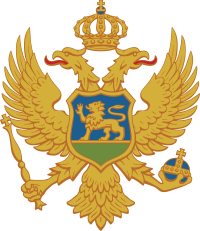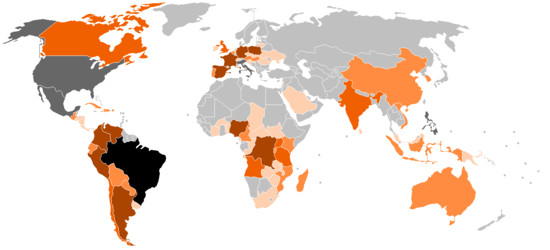Catholic Church in Montenegro
| Part of a series on |
| Montenegrins |
|---|
 |
| By region or country |
| Recognized populations |
|
Montenegro Serbia Bosnia and Herzegovina Croatia Republic of Macedonia Kosovo Albania |
| Diaspora |
|
Europe · Austria · Denmark France · Germany Italy · Luxembourg Russia · Slovenia Sweden · Switzerland United Kingdom |
|
North America United States · Canada · Mexico |
|
South America Argentina · Chile Bolivia · Brazil · Colombia |
|
Oceania Australia · New Zealand |
| Culture |
|
Literature · Music · Art · Cinema Cuisine · Dress · Sport |
| Religion |
| Language and dialects |
| Montenegrin · Serbian |
| History |
|
History of Montenegro Rulers |
The Catholic Church in Montenegro is a part of the worldwide Catholic Church, under the spiritual leadership of the Pope in Rome. There are 21,299 Catholics in Montenegro, and they form three and a half percent of the population. Most Roman Catholics are ethnic Albanians and Croats as well as some Montenegrins.
The Apostolic Nuncio to Montenegro and to Bosnia and Herzegovina is Archbishop Luigi Pezzuto.
Organisation
Latin Rite Catholics
Within Montenegro the Latin Rite Catholic hierarchy consists of the Roman Catholic Archdiocese of Bar. The Roman Catholic Diocese of Kotor is geographically located in Montenegro, but it is administratively part of the church in Croatia and is subject to the Archdiocese of Split-Makarska of that country.[1] The territory of the Diocese of Kotor (Venetian: Cattaro) corresponds to the territory of Albania Veneta of the Republic of Venice, lost to Napoleon I in 1797 (Albania Veneta was mostly Catholic).
Eastern Rite Catholics
According to CNEWA Canada, Catholics of the Eastern Catholic Churches number over 20,000 persons in Serbia and Montenegro (mostly in northern Serbia).[2] In 2003 the Apostolic Exarchate of Serbia and Montenegro was created for Greek Catholics in Serbia and Montenegro, headed by Bishop Đura Džudžar (born 1954, appointed 2003). It has 21 parishes and 22,720 faithful, consisting mostly of a group of ethnic Rusyn Greek Catholics in the region of Vojvodina.[2]
Demographics
According to the 2004 official demographic data, of the total 21,972 Roman Catholics in Montenegro, there are:
- 8,126 Albanians (36.98%)
- 6,811 Croats (31.00%)
- 5,000 Montenegrins (22.76%)
- 2,035 others (9.26%)
According to statistics published by the Archdiocese of Bar in 2006, there are a total of 12,165 Catholics under its jurisdiction, in the following settlements:
- Tuzi - 4, 510
- Podgorica - 1,738
- Bar - 1,610
- Ulcinj - 947
- Štoj - 491
- Bratica - 475
- Hoti - 440
- Koja - 404
- Sveti Đorđe - 251
- Trieshi - 249
- Gruda - 232
- Kolonza - 219
- Zupci - 180
- Cetinje - 165
- Gusinje - 80
- Klezna - 91
- Ljara - 41
- Nikšić - 30
- Šestan - 12
See also
References
External links
 Herbermann, Charles, ed. (1913). "Montenegro". Catholic Encyclopedia. New York: Robert Appleton Company.
Herbermann, Charles, ed. (1913). "Montenegro". Catholic Encyclopedia. New York: Robert Appleton Company.- http://www.catholic-hierarchy.org/country/dme.html
